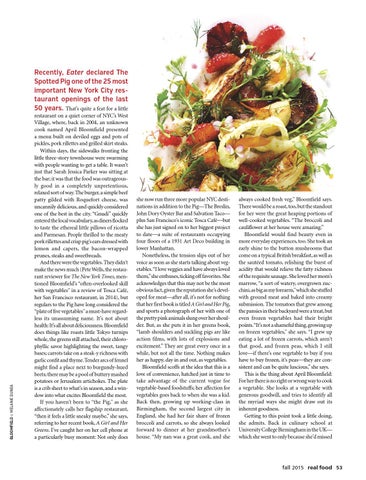BLOOMFIELD © MELANIE DUNEA
Recently, Eater declared The Spotted Pig one of the 25 most important New York City restaurant openings of the last 50 years. That’s quite a feat for a little restaurant on a quiet corner of NYC’s West Village, where, back in 2004, an unknown cook named April Bloomfield presented a menu built on deviled eggs and pots of pickles, pork rillettes and grilled skirt steaks. Within days, the sidewalks fronting the little three-story townhouse were swarming with people wanting to get a table. It wasn’t just that Sarah Jessica Parker was sitting at the bar; it was that the food was outrageously good in a completely unpretentious, relaxed sort of way. The burger, a simple beef patty gilded with Roquefort cheese, was uncannily delicious, and quickly considered one of the best in the city. “Gnudi” quickly entered the local vocabulary, as diners flocked to taste the ethereal little pillows of ricotta and Parmesan. People thrilled to the meaty pork rillettes and crisp pig’s ears dressed with lemon and capers, the bacon-wrapped prunes, steaks and sweetbreads. And there were the vegetables. They didn’t make the news much (Pete Wells, the restaurant reviewer for The New York Times, mentioned Bloomfield’s “often-overlooked skill with vegetables” in a review of Tosca Café, her San Francisco restaurant, in 2014), but regulars to the Pig have long considered the “plate of five vegetables” a must-have regardless its unassuming name. It’s not about health: It’s all about deliciousness. Bloomfield does things like roasts little Tokyo turnips whole, the greens still attached, their chlorophyllic savor highlighting the sweet, tangy bases; carrots take on a steak-y richness with garlic confit and thyme. Tender arcs of fennel might find a place next to burgundy-hued beets; there may be a pool of buttery mashed potatoes or Jerusalem artichokes. The plate is a crib sheet to what’s in season, and a window into what excites Bloomfield the most. If you haven’t been to “the Pig,” as she affectionately calls her flagship restaurant, “then it feels a little sneaky maybe,” she says, referring to her recent book, A Girl and Her Greens. I’ve caught her on her cell phone at a particularly busy moment: Not only does
she now run three more popular NYC destinations in addition to the Pig—The Breslin, John Dory Oyster Bar and Salvation Taco— plus San Francisco’s iconic Tosca Café—but she has just signed on to her biggest project to date—a suite of restaurants occupying four floors of a 1931 Art Deco building in lower Manhattan. Nonetheless, the tension slips out of her voice as soon as she starts talking about vegetables. “I love veggies and have always loved them,” she enthuses, ticking off favorites. She acknowledges that this may not be the most obvious fact, given the reputation she’s developed for meat—after all, it’s not for nothing that her first book is titled A Girl and Her Pig Pig, and sports a photograph of her with one of the pretty pink animals slung over her shoulder. But, as she puts it in her greens book, “lamb shoulders and suckling pigs are like action films, with lots of explosions and excitement.” They are great every once in a while, but not all the time. Nothing makes her as happy, day in and out, as vegetables. Bloomfield scoffs at the idea that this is a love of convenience, hatched just in time to take advantage of the current vogue for vegetable-based foodstuffs; her affection for vegetables goes back to when she was a kid. Back then, growing up working-class in Birmingham, the second largest city in England, she had her fair share of frozen broccoli and carrots, so she always looked forward to dinner at her grandmother’s house. “My nan was a great cook, and she
always cooked fresh veg,” Bloomfield says. There would be a roast, too, but the standout for her were the great heaping portions of well-cooked vegetables. “The broccoli and cauliflower at her house were amazing.” Bloomfield would find beauty even in more everyday experiences, too. She took an early shine to the button mushrooms that come on a typical British breakfast, as well as the sautéed tomato, relishing the burst of acidity that would relieve the fatty richness of the requisite sausage. She loved her mom’s marrow, “a sort of watery, overgrown zucchini, as big as my forearm,” which she stuffed with ground meat and baked into creamy submission. The tomatoes that grew among the pansies in their backyard were a treat, but even frozen vegetables had their bright points.“It’s not a shameful thing, growing up on frozen vegetables,” she says. “I grew up eating a lot of frozen carrots, which aren’t that good, and frozen peas, which I still love—if there’s one vegetable to buy if you have to buy frozen, it’s peas—they are consistent and can be quite luscious,” she says. This is the thing about April Bloomfield: For her there is no right or wrong way to cook a vegetable. She looks at a vegetable with generous goodwill, and tries to identify all the myriad ways she might draw out its inherent goodness. Getting to this point took a little doing, she admits. Back in culinary school at University College Birmingham in the UK— which she went to only because she’d missed
fall 2015 real food 53
